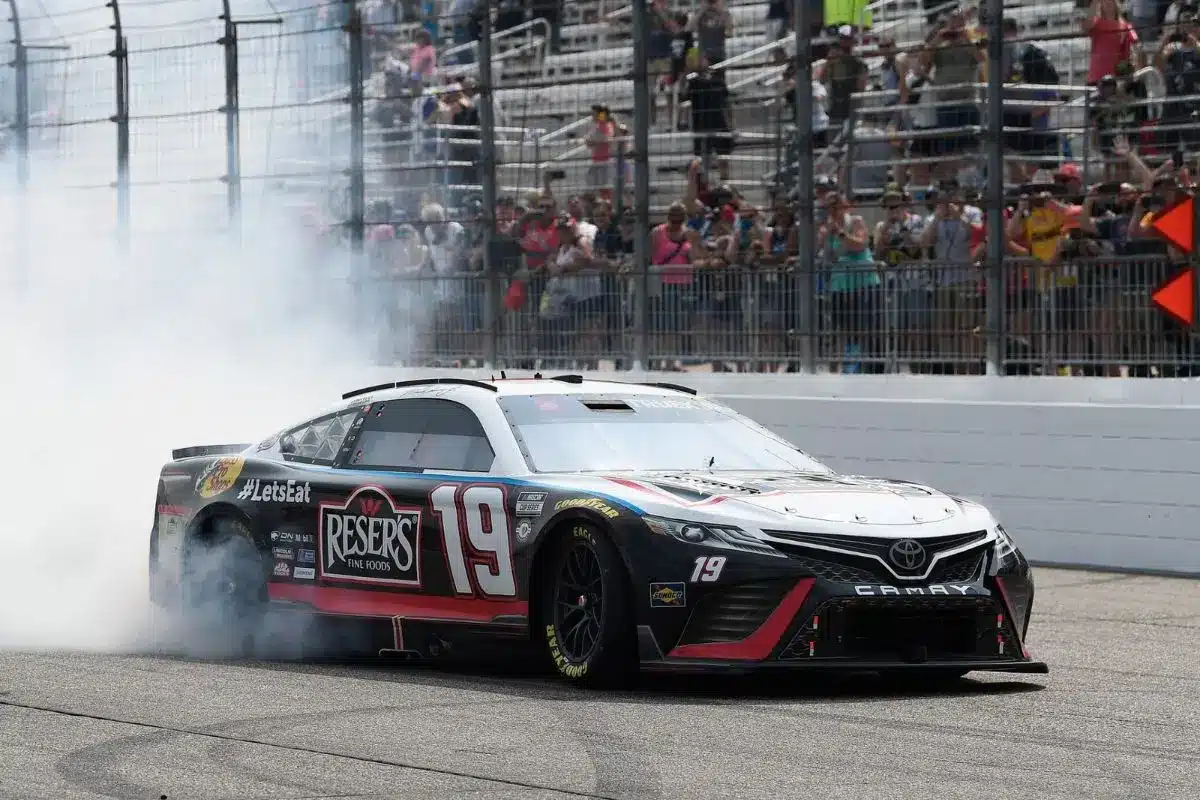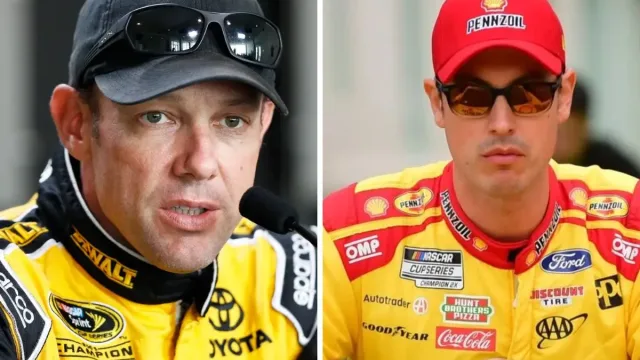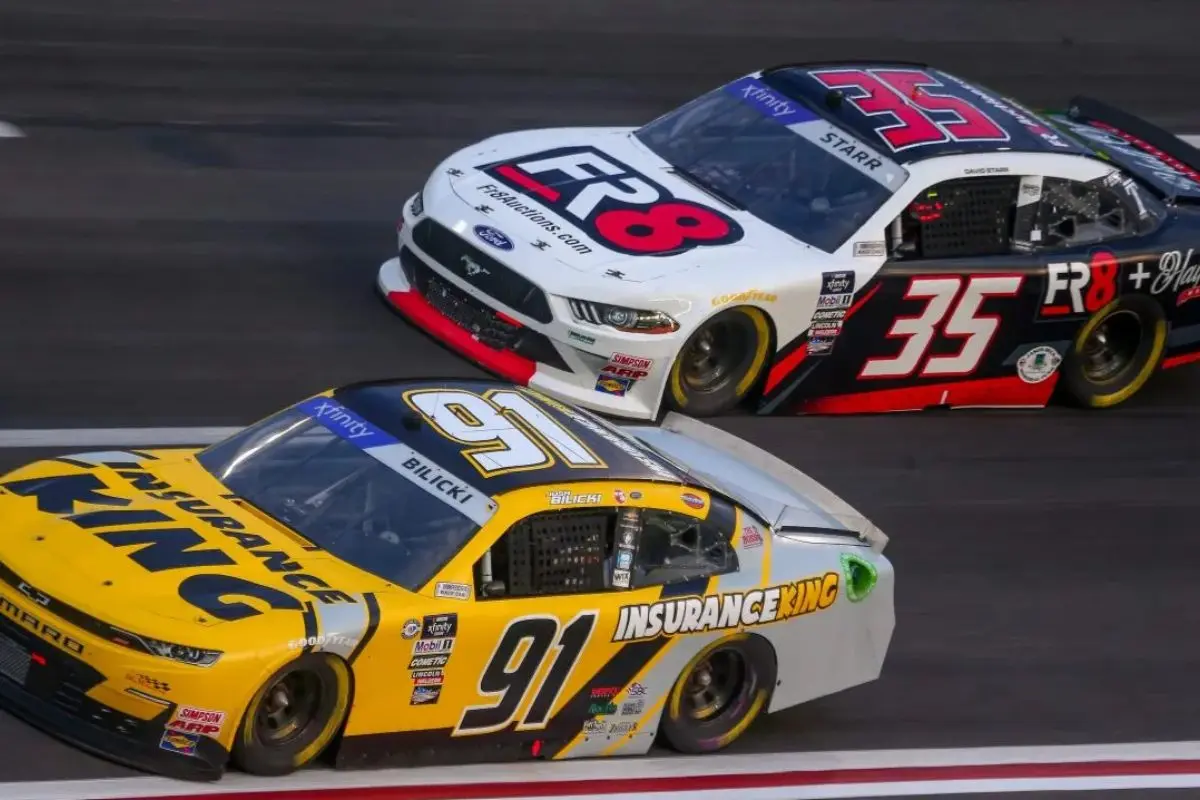The notorious crash at Martinsville, where Matt Kenseth ruthlessly wrecked Joey Logano, exemplifies the intense rivalries in NASCAR. This reckless maneuver, seen as revenge for an earlier incident at Kansas, greatly impacted both drivers’ NASCAR championship hopes and ignited debates about sportsmanship versus aggressive racing. Joey Logano condemned Matt Kenseth’s actions as “a coward move,” highlighting the personal stakes involved. Following the race, NASCAR officials faced pressure to reassess conduct guidelines, aiming to maintain the sport’s integrity. Such incidents not only shape the NASCAR championship landscape but also influence the broader dynamics of competition in NASCAR, raising questions about the future of driver rivalries.
Key Highlights
- Matt Kenseth’s deliberate crash into Joey Logano at Martinsville was seen as revenge for a previous incident in NASCAR at Kansas that affected Kenseth’s NASCAR championship chances.
- The collision resulted in a red flag during the NASCAR race, halting the event and sparking debates about aggressive racing versus unsportsmanlike conduct.
- Logano condemned Kenseth’s actions as “a complete coward move,” highlighting the emotional stakes and frustrations within NASCAR rivalries.
- NASCAR officials are reviewing the incident, with potential repercussions for Kenseth, who was parked for the remainder of the race.
- The Martinsville race exemplifies the intense pressures of NASCAR championship pursuit and the need for clearer guidelines on driver conduct.
Collision at Martinsville: Matt Kenseth Strikes Joey Logano
In a stunning turn of events at Martinsville Speedway, Matt Kenseth deliberately collided with Joey Logano, igniting a heated controversy within the NASCAR community. The incident, which unfolded during a pivotal stage of the NASCAR race, saw Kenseth in the #20 toyota/”>Toyota targeting Logano, who was leading in the #22 ford/”>Ford. The repercussions were immediate and dramatic, as Logano’s car struck the barriers, necessitating a red flag and momentarily halting the race.
This action has stirred intense debate among NASCAR fans, analysts, and drivers alike, raising critical questions about the balance between aggressive racing and unsportsmanlike behavior. Kenseth’s approach has been scrutinized for crossing the fine line that separates competitive strategy from intentional wrecking. While some argue that the incident was a calculated move borne out of rivalry, others contend that such behavior undermines the integrity of the sport.
The Martinsville collision reflects the broader tensions within NASCAR, where the stakes are perpetually high and rivalries can escalate rapidly. Kenseth’s actions could be viewed as a manifestation of deeper frustrations, possibly stemming from earlier confrontations.

However, the immediate fallout raises concerns about the potential normalization of retaliatory tactics in racing. As the NASCAR community grapples with this incident, it becomes clear that the consequences of Kenseth’s actions extend beyond Martinsville; they challenge the very ethos of competition and sportsmanship in a sport that thrives on both rivalry and respect.

Revenge for Kansas: Matt Kenseth’s Retaliation Against Joey Logano
The collision at Martinsville was not merely an isolated incident but rather a calculated act of revenge rooted in the previous encounter at Kansas Speedway. In that NASCAR race, Joey Logano’s aggressive tactics had cost Matt Kenseth a chance at advancing in the Chase for the NASCAR Championship, a crucial moment that left Kenseth simmering with frustration. Logano, riding high on the momentum of three consecutive wins, was a formidable competitor, and Kenseth’s inability to contend for the title only intensified his desire for retribution.
As the Martinsville NASCAR race unfolded, Logano was leading and seemingly poised to extend his winning streak. However, Kenseth—already multiple laps down due to earlier misfortunes—was determined to exact his revenge. With calculated precision, he executed a maneuver that sent Logano crashing into the barriers, abruptly halting his pursuit of victory and greatly impacting his NASCAR championship aspirations. This act was not merely an emotional outburst; it was a tactical decision reflecting the complex dynamics of rivalry in NASCAR.
Kenseth’s actions at Martinsville exemplified the fierce competition and raw emotions that define the sport. By retaliating in such a dramatic fashion, he not only sought to settle a personal score but also sent a clear message to his competitors about the consequences of aggressive driving.
This incident serves as a reminder of how closely intertwined personal vendettas and race plans can be within the NASCAR racing, where every move is scrutinized and every rivalry has the potential to escalate dramatically.
Joey Logano Reacts to the Crash: “A Coward Move”
Emotions ran high in the aftermath of the crash, as Joey Logano did not shy away from expressing his disdain for Matt Kenseth’s actions. Labeling Kenseth’s maneuver as “a complete coward move,” Logano articulated his frustration over the incident, particularly in contrast to their previous encounter in Kansas.
In that race, Logano believed that his bump to Kenseth was a legitimate part of competitive racing, an assertion he felt undermined by Kenseth’s reckless decision to take out the race leader while being laps down.
“I think what happened at Kansas is a completely different deal.”
“We were racing for the win and he blocks you a few times and then we raced hard and he blocked me the last time and we spun out. That’s what happened there. Here it was just a complete coward move, especially for a championship race car driver and race team. Just a complete coward. I don’t have anything else to say. It’s a chicken-you-know-what move to completely take out the leader when your race is over.”
“Just a complete coward. I don’t have anything else to say.” – Joey Logano
Logano’s reaction highlights the complexities of rivalry in NASCAR, where the line between aggressive racing and unsportsmanlike conduct can often blur. His comments reflect a broader sentiment among drivers regarding the integrity of the sport, as they navigate the fine balance between competition and respect.
Key points from Logano’s reaction include:
- Emotional Outburst: Logano’s frustration highlights how deeply personal rivalries can affect performance.
- Contrast with Kansas: The distinction he draws between the two incidents reflects his views on acceptable racing behavior.
- Perception of Sportsmanship: Logano’s remarks call into question the ethics of racing tactics in high-stakes situations.
- Determination to Succeed: His focus on recovery showcases the resilience required in NASCAR.
- Broader Implications: This incident may influence how other drivers approach on-track rivalries.
NASCAR’s Response: Officials Assessing Possible Penalties
Following the heated exchange between Joey Logano and Matt Kenseth, NASCAR officials found themselves in a position to evaluate the implications of the incident on the sport’s integrity. Kenseth’s decision to deliberately wreck Logano, particularly while multiple laps down, has raised notable concerns regarding the enforcement of sportsmanship and safety standards within the NASCAR framework.
Steve O’Donnell, NASCAR’s Executive Vice President, expressed his disappointment, highlighting that this incident deviated from the expected norms of competitive racing. The context of Kenseth’s actions—coming from a position far behind in the race—suggests a premeditated strategy rather than a spontaneous reaction to on-track competition. Such behavior threatens to undermine the spirit of competition that NASCAR seeks to uphold.
“We were certainly disappointed with what took place tonight on the race track… Like we always do, there’s still a lot to digest from what happened tonight. We’ll do that. We’ll have some additional conversations and probably come out with something, if there is anything to discuss, on Tuesday.”
“In our minds, that’s a little bit different than two drivers really going after it coming out of Turn 4 for a win versus what happened tonight.” – Steve O’Donnell
While officials have parked Kenseth for the remainder of the race, finishing him in 38th place, they have stopped short of immediate penalties, citing the necessity for a thorough review. This cautious approach reflects NASCAR’s desire to maintain fairness and due process, ensuring that any disciplinary measures are justified and proportional to the severity of the incident.
The potential for further repercussions looms, as officials weigh the broader implications for the sport and its reputation. In the coming days, the NASCAR governing body will scrutinize available footage and testimonies to arrive at a decision that reinforces its commitment to integrity, while also addressing the complexities of driver interactions on the track.
Post-Race Tensions: Reactions from Teams and Fellow Drivers
Steering through the aftermath of the incident, teams and fellow drivers expressed a mix of frustration and determination as they processed the implications of Kenseth’s actions. The collision not only impacted the NASCAR championship landscape but also ignited a complex dialogue surrounding sportsmanship, rivalry, and emotional intensity in NASCAR.
Logano’s crew chief, Todd Gordon, remained resolute, emphasizing the team’s commitment to refocusing their efforts on upcoming races, particularly with hopes of clinching a victory at Texas.
“go to Texas (the next stop on the schedule) and win.”
“We’ve done it before, We’ll do it again.” – Todd Gordon
- Sympathy for Kenseth: Jeff Gordon, a NASCAR championship contender, acknowledged the emotional turmoil that can lead to regrettable decisions in the heat of competition.
“I couldn’t quite see what the 22’s role (Logano) played in it.”
“As soon as I went by I thought, ‘Wow, did I just see that?’
“I also put myself in Matt’s shoes. I could relate. I could relate to frustration getting the best of you. … You might have some regrets later, but I understand why you make that choice at the moment.” – Jeff Gordon
- Focus on the Future: Gordon’s insistence on moving forward highlighted a collective desire to channel energies into performance rather than dwelling on past grievances.
- Rivalry Amplified: Fellow drivers recognized that such incidents often heighten rivalries, intensifying the drama of the Chase.
- Understanding the Stakes: Many competitors expressed empathy towards the pressures that drivers face as they labor for NASCAR championship success.
- Calls for Accountability: Some team members called for clearer guidelines around on-track conduct to prevent similar incidents in the future.
“You never like to be in these situations, They really stink to be honest with you, but sometimes you get put in these spots and you’ve got to try to keep respect in the garage area. You can’t get yourself ran over. …” – Matt Kenseth
“They won’t let me get to him” – Joey Logano
As the dust settled, the Martinsville race became a microcosm of the high-stakes environment that NASCAR embodies, with its intricate blend of passion, competition, and the push for excellence.
News in Brief: Matt Kenseth Ruthlessly Wrecks Joey Logano
The infamous crash at Martinsville exemplifies the volatile nature of NASCAR, where rivalries can culminate in dramatic confrontations. Kenseth’s calculated retaliation against Logano reflects deeper tensions stemming from previous incidents, particularly the Kansas race.
Reactions from Logano and fellow competitors underscore the broader implications of such aggressive maneuvers on racing culture and driver relations. As NASCAR officials deliberate on potential penalties, the incident serves as a catalyst for ongoing discussions about sportsmanship and accountability within the sport.
ALSO READ: Joey Logano’s Controversial Plan to Help Ryan Blaney May Cost Him Everything in the NASCAR Playoffs


